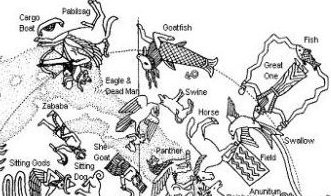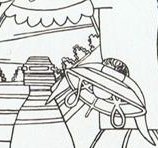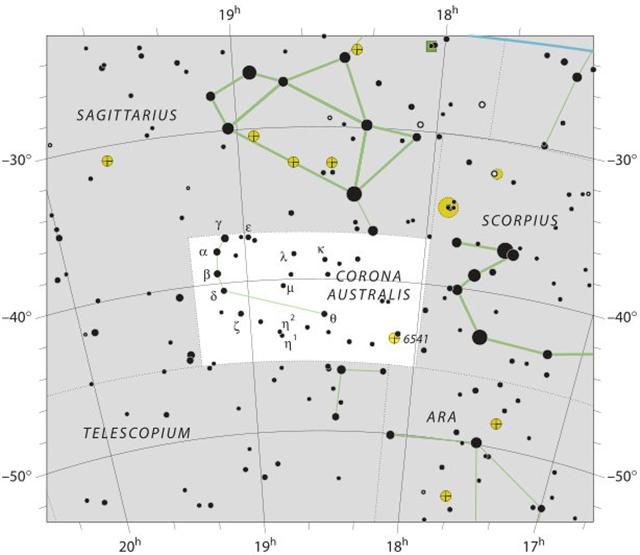At
the
end
there
was
a
Cargo
Boat
and
this
was
probably the
place
where
the
Milky
Way
looked
like
the
mouth
of a
robber's
stick:

...
All
was
now
ready
for
departure
except
that
there
was
no
fire
in
the
smithy.
The
ancestor
slipped
into
the
workshop
of
the
great
Nummo,
who
are
Heaven's
smiths,
and
stole
a
piece
of
the
sun
in
the
form
of
live
embers
and
white-hot
iron.
He
seized
it
by
means
of a
'robber's
stick'
the
crook
of
which
ended
in a
slit,
open
like
a
mouth.
He
dropped
some
of
the
embers,
came
back
to
pick
them
up,
and
fled
towards
the
granary;
but
his
agitation
was
such
that
he
could
no
longer
find
the
entrances.
He
made
the
round
of
it
several
times
before
he
found
the
steps
and
climbed
onto
the
flat
roof,
where
he
hid
the
stolen
goods
in
one
of
the
skins
of
the
bellows,
exclaiming:
'Gouyo!',
which
is
to
say.
'Stolen!'
...
The
cargo
in
this
boat
looks
like
our
symbol
for
the
black
new
moon
(●).
Whereas
the
full
moon
sign
has
the
opposite
face
(o).
... When the
new moon
appeared
women
assembled
and bewailed
those who
had died
since the
last one,
uttering the
following
lament:
'Alas! O
moon! Thou
has returned
to life, but
our departed
beloved ones
have not.
Thou has
bathed in
the
waiora a
Tane,
and had thy
life
renewed, but
there is no
fount to
restore life
to our
departed
ones. Alas
...

The
Cargo
Boat
was
the
last
of
the
15
southern
stars
on
the
Path
of
Ea and
coincided
with
Corona
Australis,
just
after
the
Sting
of
the
Scorpion.
Here
the
stars
at
the
end
of
the
constellation
are describing a
curve.
And
the
outline
of
the
Teapot
(t-pot)
in
Sagittarius
was above
and
looking
much
like
a
kind
of
headgear
(ha˙):


The
Chinese
had
a
Horse
as
mnemonic
for
their
25th
stations
Star
and
possibly
it
could
allude
to
the
right
leg
of
the
Sagittarius
horse.
| 23 |
Ghost |
ρ Gemini ? |
Goat |
(112.1) |
Jul 11 (192) |
192 = 175 + 17 |
| 24 |
Willow |
δ Hydrae |
Stag |
(129.6) |
Jul 28 (209) |
209 = 192 + 17 |
| 25 |
Star |
α Hydrae (Alphard) |
Horse |
(142.3) |
Aug 10 (222) |
222 = 209 + 11 |
| 26 |
Extended Net |
ε Hydrae / μ Hydrae |
Ox |
(131.9 / 157.1) |
Jul 30 (211) / Aug 25 (237) |
237 = 222 + 15 |
| 27 |
Wings |
α Crateris (Alkes) |
Snake |
(165.6) |
Sep 2 (245) |
245 = 237 + 8 |
| 28 |
Chariot |
γ Corvi (Gienah) |
Worm |
(185.1) |
Sep 22 (265) |
265 = 245 + 20 |
| September equinox |
Das
Pferd
- which
I though
resembled
the star
name
Al-Phard
-
is
German
for 'the
horse',
but at
first I
saw no
information
in Allen
regarding
a
horse in
the
Hydra
constellation.
However,
after
reading
more
thoroughly
I found:
"Al Sufi
mentioned
an early
Arab
figure,
Al
Hail,
the
Horse,
formed
from
stars
some of
which
now
belong
to our
Hydra,
but more
to Leo
and
Sextans."
 |
 |
 |
 |
| Ga3-17 |
Ga3-18 (77) |
Ga3-19 |
Ga3-20 |
| JUNE 5 |
6 (157 = 314 / 2) |
7 (15 * 29Ż + Ż) |
8 |
| no star listed (140) |
Markab Velorum (141.5), Al Minhar al Asad (141.6) |
Star-25
ANA-HEU-HEU-PO |
Al Tarf-7 |
| ALPHARD (142.3), ω Leonis (142.6), τ╣ Hydrae (142.7) |
ψ Velorum (143.3), ALTERF, τ▓ Hydrae (143.4), ξ Leonis (143.5) |
| August 8 (220) |
9 |
10 |
11 |
| ║August 4 (216) |
5 (*137) |
6 |
7 |
| 'July 12 (193) |
13 (*114) |
14 |
15 |
| "June 28 (179) |
29 |
30 (*101) |
"July 1 |
| NAKSHATRA DATES: |
| DECEMBER 5 |
6 |
(*261 = 9 * 29) |
8 (342) |
| Dai (323.5), β Equulei (323.8) |
γ Pavonis (324.1), Yan (324.6) |
Al Sa'd al Su'ud-22 / Emptiness-11 |
no star listed (326) |
| Tsin (325.2), Alphirk (325.7), SADALSUD, ξ Gruis (325.9) |
| February 7 (403) |
8 |
9 (40) |
10 (*326) |
| ║February 3 |
4 (400) |
5 (36) |
6 (*322) |
| 'January 11 |
12 |
13 (378) |
14 (*299) |
| "December 28 |
29 |
30 (364) |
31 (*285) |

Could
the
front right leg
of
the
horse
in
Sagittarius be
the
cargo
onboard
the
Cargo
Boat?
From
heliacal
Alphard
at
Ga3-19
to
α
Corona
Australis
(Alphekka
Meridiana)
at
Ga8-23
there
were
290
-
142
=
148
days.
Or
counted
the
other
way:
142
+
365
-
290
=
217.
 |
 |
 |
 |
 |
| Ga8-22 |
Ga8-23 |
Ga8-24 (227) |
Ga8-25 |
Ga8-26 |
| NOVEMBER 1 |
2 (306) |
3 |
4 |
5 |
| 19h (289.2) |
Al Baldah-19 / Cargo Boat-91 |
Aladfar (291.1), Nodus II (291.5), ψ Sagittarii (291.6), θ Lyrae (291.8) |
ω Aquilae (292.1), ρ Sagittarii (292.6), υ Sagittarii (292.7) |
Arkab Prior (293.0), Arkab Posterior, Alrami (293.2), χ Sagittarii (293.6) |
| λ Aquilae (Ant.) (289.1), γ Cor. Austr (289.3), τ Sagittarii (289.4), ι Lyrae (289.5), δ Cor. Austr. (289.8) |
AL BALDAH, Alphekka Meridiana (290.1), β Cor. Austr. (290.2) |
| January 4 |
5 (370) |
6 |
7 |
8 |
| ║December 31 (*285) |
║January 1 (366) |
2 |
3 |
4 |
| 'December 8 |
9 |
10 (*264) |
11 (345) |
12 |
| "November 24 |
25 (329) |
26 (*250) |
27 |
28 |
| NAKSHATRA DATES: |
| MAY 3 (123) |
4 |
5 |
6 |
7 (492) |
| WEZEN (107.1), τ Gemini (107.7), δ Monocerotis (107.9) |
no star listed (108) |
λ Gemini (109.4), Wasat (109.8) |
no star listed (110) |
Aludra (111.1), Propus (111.4), Gomeisa (111.6) |
| July 6 |
7 |
8 |
9 (190) |
10 |
| ║July 2 |
3 (*104) |
4 (185) |
5 |
6 |
| 'June 9 |
10 (*81) |
11 |
12 |
13 (164) |
| "May 26 (*66) |
27 |
28 (148) |
29 |
30 |
 |
217 + 48 = 265 |
| 80 + 137 = 217 |
| Ab1-37 |
137 + 227 = 364 |
| 148 + 217 = 365 |
Al Baldah (π Sagittarii, at the back of the head of the Archer) rose in the same day as Alphekka Meridiana (which, however, cannot be easily perceived in Hevelius' picture). Both the head of the 'Cavalry Officer' and the front leg of his horse could have been onboard the Southern Crown. In Ga8-22 the illuminated sky (ragi) is above and nuku (the land) below and upside down.
| Nuku 1. Pau.: nuka, crowd, throng. Ta.: nu˙, army, fleet. Mg.: nuku, a host, army. 2. Mgv.: nuku, land, country, place. Sa.: nu'u, district, territory, island. Churchill. |
The end of side a has 5 glyphs with nakshatra Wasat (Middle) in the middle - at glyph 227 (π). And possibly a final curve has been illustrated in the preceding Ga8-23
 |
100 |
 |
 |
| Ga5-15 (125) |
Ga8-23 (226) |
ha˙ |
which in rongorongo times was 290 days after 0h.
| Hau Hau = Thread, line, string, ribbon; this is the name of the fibres of the hauhau tree formerly used to make twine, cloth, etc.; hau kahi, fishing line for tuna; hau here, line for eel trap; hau moroki, strong, tough line, thread; hau paka, fibres of the hauhau tree, which were first soaked in water, then dried to produce a strong thread. Ha'u = Hat. Vanaga.
Hat, cord; the tree Triumfetta semitriloba. Van Tilburg. Ta.: The tree Hibiscus tiliaceus. Henry.
Hau. 1 a. Hibiscus. b. Wick. P Pau.: fau, hibiscus. Mgv.: hau, id. Mq.: fau, hau, id. Ta.: fau, id. 2. To contribute. Ta.: aufau, to pay, to contribute, to subscribe. 3. Hat, cap, helmet; hakarere ki te hau, to take off the hat. Ta.: fauurumaa, war bonnet. 4. Dew; hakaritorito ki te hau, to bleach in the dew. P Mgv., Mq.,Ta.: hau, dew. 5. To blow freshly, coolness, zephyr, salubrious, breeze, wind (hahau, ahau); kona hauhau, kona hahau, a breezy spot; ahau ora, agreeable breeze; hakahahau, to hang out in the air; hakaahau, to blow. T Mgv.: hau, to blow, blusterous, to breathe. Haua, hoarse. (Hauha); araha hauha, to wait for, to look forward to. Hauhau, 1. dog (onomatopoetic). 2 a. To scratch, to scrape, to rub. b. Wood used in plowing fire. 3. (hau 5). Haumaru (hau 5 - marumaru) cool, cold. Hau¨, to replace. Hauva, twin, cut T. Hauvaero (hau 3 - vaero) plume, aigrette, head ornament. Hauvarikapau (hau 3 - varikapau) plume, aigrette, head ornament. Churchill.
Pau.: Hau, superior, kingdom, to rule. Mgv.: hau, respect. Ta.: hau, government. Mq.: hau, id. Sa.: sauā, despotic. Ma.: hau, superior. Hauhau, to attack. Ma.: hau, to chop. Churchill.
Sa.: fau, to tie together, to fasten by tying, the tree (Hibiscus tiliaceus) whose bast is used for cord, the kava strainer made therefrom, strings in various uses; fafau, to lash on, to fasten with sennit; faufau, to fasten on, to tie together. To.: fau, to fasten up the hair, the name of the hibiscus, the kava strainer made therefrom; faufau, to fasten the outriggers of small canoes; hau, to fasten to; fehauaki, to tie. Fu.: fau, the hibiscus, the kava strainer; fa¨, fafa¨, fa¨fa¨, to attach, to tie. Niuē: fau, fafau, to make by tying. Fotuna: no-fausia, to tie, to fasten. Ta.: fau, the hibiscus; fafau, to tie together. Pau.: fau, the hibiscus. Nuguria: hau, id. Ma.: hau, to bind, to fasten together; whau, a shrub; whauwhau, to tie. Ha.: hau, name of a tree with a practicable bark. Mq.: hau, the hibiscus. Mgv.: hau, id.; hahau, to join or tie with cords. Nukuoro: hau, the hibiscus, a garland. Mg.: au, the hibiscus. Vi.: vau, the hibiscus; vautha, to bind together. Churchill 2. |

... In many Polynesian cultures the bodies of gods were conceived of as covered with feathers and they were frequently associated with birds: in Tahiti and the Society Islands, bird calls on the marae signaled the presence of the gods. Hawaiian feathered god figures generally depict only the head and neck of the god ...
There were 3 Babylonian god paths, in descending order, and the last star of all in this triplet was the Cargo Boat (possibly Alphekka Meridiana).
By
adding
the
stars
in
the
list
of
Babylonian
Ecliptic
Constellations
the
total
becomes
91:
| Ecliptic path |
20 stars |
| Path of Enlil |
33 northern stars |
71 |
| Path of Anu |
23 equatorial stars |
| Path of Ea |
15 southern stars |
| |
91 stars |
|














